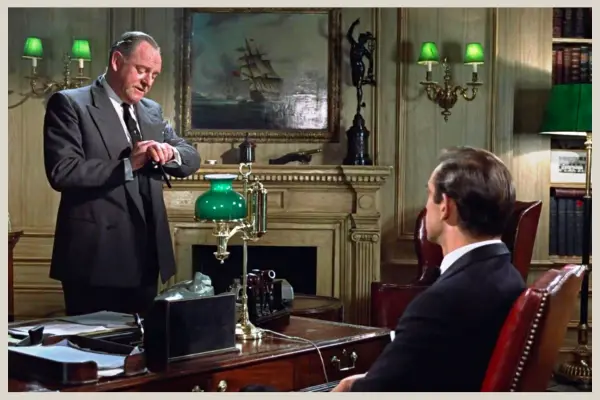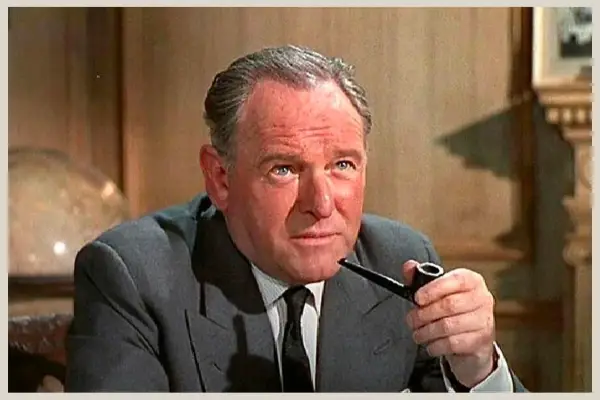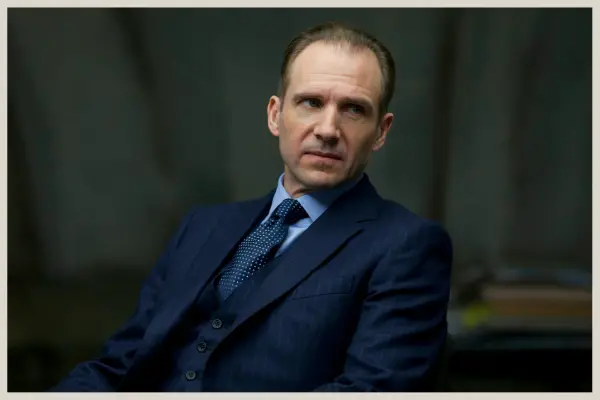M in The World of James Bond
As one of the most enduring and captivating characters in the James Bond series, ‘M’ has played a pivotal role in shaping the narrative and the world of espionage that Bond inhabits.
As the head of the British Secret Service, MI6, M has been a constant figure throughout the series, providing guidance, support, and authority to 007 in his thrilling and dangerous adventures. The enigmatic figure has been portrayed by four actors over the years, each bringing their unique touch to the role and further enriching the complex tapestry of the James Bond universe.
M’s importance in the James Bond series cannot be understated, as the character is not only Bond’s superior but also a representation of the British government’s intelligence apparatus. As the person responsible for assigning missions, providing strategic insight, and holding James Bond 007 accountable for his actions, M serves as a crucial anchor for the series, grounding the fantastical elements with a sense of realism and authority.
M is the embodiment of the moral compass and guiding principles that underpin the work of MI6, often acting as a mentor and confidant to Bond while also maintaining a strict and professional distance.
From the stern and unyielding portrayal by Bernard Lee in the early films to the more compassionate and nuanced interpretation by Judi Dench and the recent and more hands-on portrayal by Ralph Fiennes, M has remained a central figure in the series, helping to define the tone and direction of the Bond films.
In this M character bio, we will delve deeper into who M is, exploring the origins of the role in Ian Fleming’s novels, the evolution of the character in the movies, and the various actors who have brought M to life on screen.

We’ll also examine M’s relationship with James Bond, the memorable interactions between the two, and the impact of the character on the spy genre and popular culture. So, join us as we unravel the enigma of M and celebrate the enduring legacy of this iconic figure in the James Bond series.
The Origins of M in the Novels
M, the enigmatic head of MI6, was first introduced to readers in Ian Fleming’s 1953 novel, Casino Royale, the inaugural story in the James Bond series.
Fleming’s M was inspired by several real-life figures, including his former superior, Rear Admiral John Godfrey, and Sir Stewart Menzies, who headed MI6 during World War II. Drawing from his experiences as a naval intelligence officer, Fleming crafted a character that embodied the authority, intelligence, and determination he observed in these individuals.
M continued to feature prominently in the subsequent Bond novels penned by Fleming, as well as in those written by later authors such as John Gardner, Raymond Benson, and more recently, Anthony Horowitz. Each author has added their unique touch to the character, further developing and refining M’s personality and leadership style.
In the novels, M is portrayed as a no-nonsense, stern, and somewhat aloof leader who expects the highest level of professionalism and loyalty from his agents. M has a deep understanding of the world of espionage and isn’t afraid to make extremely difficult decisions in the interest of national security.
Despite this tough exterior, M also demonstrates a genuine concern for the well-being of his agents, including Bond, and is not immune to the emotional toll that the job can take.
Throughout the books, M’s relationship with Bond is a complex one. While M is initially skeptical of Bond’s maverick tendencies, he comes to rely on and trust his top agent implicitly. This dynamic evolves over time, reflecting the changing landscape of espionage and the shifting priorities of MI6.
The character of M is a testament to the enduring legacy of the Bond novels, as the series continues to captivate readers and explore the intricacies of the world of intelligence and espionage.

The Evolution of M
As the James Bond series transitioned from the page to the silver screen, M’s character underwent several transformations, adapting to the changing times and evolving cinematic landscape. Each actor who has taken on the role of M has brought their unique interpretation to the character.
Bernard Lee was the first to portray M, appearing in eleven Bond films from 1962’s Dr. No to 1979’s Moonraker. Lee’s M was a stern, authoritative figure who expected nothing less than excellence from his agents. His portrayal was heavily influenced by Fleming’s novels, and his relationship with Bond was characterized by a mix of professional respect and occasional frustration with Bond’s unorthodox methods.
Robert Brown took over the role of M in 1983, making his debut in Octopussy and continuing through 1989’s Licence to Kill. Brown’s portrayal was similar to Lee’s, maintaining the sense of authority and stern demeanor. However, there was a subtle shift in the dynamic between M and Bond, with M demonstrating a slightly more lenient attitude towards Bond’s rule-bending.
In 1995, Judi Dench became the first woman to portray M, bringing a fresh perspective to the role in GoldenEye. Dench’s M was a more complex character, balancing authority with empathy and demonstrating a deeper understanding of the emotional challenges faced by her agents. Her relationship with Bond was more intimate, and although there was professional distance between the two, the respect she had for him was clearer than other versions of M.
Ralph Fiennes assumed the role of M in Skyfall (2012) and has continued to portray the character in subsequent films. Fiennes’ M is a blend of the previous portrayals, combining authority and empathy while also showcasing a more hands-on approach to his duties. His M is often directly involved in field operations, highlighting the changing nature of intelligence work in the modern era.
Over the years, James Bond’s boss, M has evolved to reflect the shifting dynamics of espionage, politics, and society. Each actor has captured the essence of M while also adapting to the unique challenges and expectations of each era, ensuring the character remains a vital and engaging presence in the James Bond series.
Key Actors and Their Portrayals
Bernard Lee (1962-1979)
Bernard Lee‘s portrayal of M from 1962 to 1979 laid the foundation for the character’s on-screen presence and set the tone for subsequent actors who took on the role. Lee appeared as M in eleven Bond films, beginning with “Dr. No” in 1962 and concluding with “Moonraker” in 1979. His interpretation of M was heavily influenced by Ian Fleming’s novels, and he brought to life the stern, authoritative figure that Bond fans had come to know and respect.
As the head of MI6, Lee’s M embodied the classic British archetype of the stern, no-nonsense authority figure. He was a disciplined and demanding leader, expecting the utmost professionalism and loyalty from his agents. Lee’s M frequently found himself exasperated by Bond’s penchant for bending the rules and taking risks, but he also recognized Bond’s extraordinary skills and unwavering dedication to his missions.

Lee’s M maintained a strictly professional relationship with Bond, often displaying a sense of detachment and formality. Despite this, there were moments when M showed genuine concern for Bond’s well-being, hinting at a deeper understanding of the challenges and dangers that his top agent faced.
Bernard Lee’s iconic portrayal of M has left an indelible mark on the James Bond series, establishing a character that would continue to evolve and adapt to the changing world of espionage and cinema in the decades to come. His performance set the standard for all future portrayals of M and helped to shape the character’s ongoing legacy.
Robert Brown (1983-1989)
Robert Brown stepped into the role of M in 1983, following the departure of Bernard Lee. Brown made his debut as M in “Octopussy” and continued to portray the character in three more films, concluding with “Licence to Kill” in 1989. Brown’s interpretation of the character was influenced by his predecessor, and he maintained the stern, authoritative demeanor that had become synonymous with M.
As the head of MI6, Brown’s M carried on the tradition of being a disciplined and demanding leader who expected unwavering loyalty and professionalism from his agents. While he was often critical of Bond’s unorthodox methods and risk-taking, Brown’s M also demonstrated a slightly more lenient attitude towards Bond’s rule-bending, recognizing the effectiveness of his top agent in getting the job done.

Brown’s portrayal of M maintained the professional dynamic with Bond that had been established by Bernard Lee. However, there were subtle shifts in their relationship, with M occasionally showing a hint of understanding and empathy for the challenges Bond faced in his line of work. This added a layer of complexity to the character, paving the way for further evolution in subsequent portrayals.
Robert Brown’s time as M helped to bridge the gap between the classic Bond era and the more modern interpretations of the character, ensuring that the role of M remained a vital and consistent presence in the series. Brown’s performance contributed to the ongoing development of the character, adding nuance and depth to M’s on-screen presence.
Judi Dench (1995-2012)
Judi Dench‘s groundbreaking portrayal of M began in 1995 with “GoldenEye” and continued through six more films, concluding with “Skyfall” in 2012. As the first woman to take on the role, Dench brought a fresh perspective and a new dynamic to the character, creating a more nuanced and complex M that resonated with audiences and critics alike.
Dench’s M made an explosive entrance in “GoldenEye,” immediately asserting her authority and breaking stereotypes by taking on a traditionally male role. Her appointment as a woman in a position of power was emphasized in the film, with M boldly calling Bond a “sexist, misogynist dinosaur” and a “relic of the Cold War.” This bold statement set the tone for her tenure, showcasing a fearless leader who was unafraid to challenge the status quo and confront the men under her command.
Dench’s M was a powerful and confident leader who balanced authority with empathy. Her portrayal showcased a deeper understanding of the emotional challenges faced by her agents, and she was not afraid to express her concern for their well-being. She memorably quipped that she had no problem with her lack of “balls” when it came to making tough decisions, emphasizing her strength and determination as the head of MI6.

In her interactions with Bond, Dench’s M displayed a unique blend of maternal care and professional distance. Their relationship was more intimate than in previous portrayals, often venturing into mentor-like territory, but M still maintained firm boundaries and high expectations for her top agent. This dynamic added depth and richness to the bond between the two characters, making their interactions all the more compelling.
Judi Dench’s tenure as M has left a lasting impact on the James Bond series, with her portrayal being widely regarded as one of the most memorable and influential interpretations of the character. Dench’s M was a trailblazer, setting the stage for further evolution and growth in the role and helping to shape the future of the series.
Ralph Fiennes (2012-present)
Ralph Fiennes took over the role of M in 2012’s “Skyfall” and has continued to portray the character in subsequent films. Building on the foundation laid by his predecessors, Fiennes’ M combines elements of authority, empathy, and hands-on leadership, creating a well-rounded and engaging portrayal that resonates with modern audiences.
Fiennes’ M is a blend of the previous portrayals, maintaining the stern demeanor and high expectations of Bernard Lee and Robert Brown, while also embracing the more compassionate and empathetic approach introduced by Judi Dench. This combination allows for a multifaceted character who is both a commanding figure and a supportive leader, understanding the emotional and psychological challenges faced by his agents.
A distinguishing aspect of Fiennes’ portrayal is M’s military background. As a former soldier, M brings tactical expertise and firsthand knowledge of combat situations to his role as the head of MI6. This experience informs his decision-making and leadership style, adding credibility and depth to the character. Fiennes’ M is not just confined to the office; he is often directly involved in the action, highlighting the changing nature of intelligence work in the modern era. This hands-on approach showcases M’s commitment to his duties and willingness to put himself in harm’s way.

The relationship between Fiennes’ M and Bond continues to evolve, maintaining a professional dynamic while also exploring deeper emotional connections. As M navigates the complexities of modern espionage and politics, his bond with Bond becomes even more critical, emphasizing the importance of trust and loyalty in their line of work.
Ralph Fiennes’ portrayal of M adds a new layer of depth and complexity to the character, ensuring that M remains a vital and engaging presence in the ongoing James Bond series. By drawing on the strengths of past portrayals and adapting to the challenges of the modern world, Fiennes’ M is well-equipped to lead MI6 into the future.
Professional Dynamics between M and Bond
The professional dynamics between M and James Bond are a critical aspect of their relationship, as M serves as Bond’s superior and the ultimate authority figure within MI6. Throughout the series, M’s role has been to provide guidance, oversight, and occasional reprimands to Bond as he carries out his missions in his own way.
While Bond often challenges M’s authority with his unorthodox methods and risk-taking, their mutual respect and understanding of the stakes involved in their line of work ultimately bind them together.
Memorable interactions and moments
Over the years, M and Bond have shared numerous memorable interactions and moments that showcase their unique relationship.
Bernard Lee was known for his sharp tongue, and in Goldfinger he’s angry with Bond after Jill Masterson‘s death, who Auric Goldfinger has killed for sleeping with Bond. He tells him, ‘You’ve hardly distinguished yourself, have you? You were supposed to observe Mr. Goldfinger, not borrow his girlfriend.’
Another dressing down for Bond in GoldenEye, where Judi Dench is making her debut, and she calls him a ‘sexist, misogynist dinosaur’ and a ‘relic of the Cold War.’ But the emotional farewell between Dench’s M and James Bond in Skyfall shows the deep respect they had for one another.
Watch how M calls Bond a sexist, misogynist dinosaur
The evolution of their relationship throughout the series
The relationship between M and Bond has evolved significantly throughout the series. In the earlier films, the dynamic between M and Bond was more formal and distant, with M serving as a stern and somewhat detached authority figure.
However, as the series progressed and new actors took on the role of M, the relationship evolved to include elements of mentorship, empathy, and even familial care. Judi Dench’s portrayal, in particular, brought a deeper emotional connection between the two characters, while Ralph Fiennes’ M maintains a balance between authority and understanding.
M’s Influence on the Spy Genre and Popular Culture
M’s character has had a significant impact on the spy genre, both in film and television. As the head of MI6 and Bond’s superior, M has become a symbol of authority and leadership in espionage narratives.
Many subsequent spy films and TV shows have included characters similar to M, often as the protagonist’s boss or handler, responsible for overseeing missions and providing guidance to agents in the field.
M’s presence has helped to establish certain conventions and tropes within the genre, including the briefing scene, where agents receive their assignments and gadgets, and the debriefing scene, where they report back on the mission’s success or failure.
M in the World of James Bond
The character of M has played an integral role in the James Bond series, serving as a vital authority figure and guiding force for the iconic British spy. From the character’s origins in Ian Fleming’s novels to the various portrayals on the big screen, M has evolved alongside the series, reflecting the changing times and the complexities of modern intelligence work.
The dynamic relationship between M and James Bond has been a cornerstone of the series, providing memorable interactions, emotional depth, and a sense of continuity across films. M’s influence on the spy genre and popular culture has been significant.
As the James Bond series continues to captivate audiences worldwide, the character of M remains an essential and enduring presence, embodying the values of leadership, duty, and loyalty that lie at the heart of the franchise.





